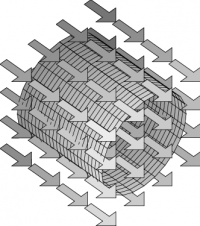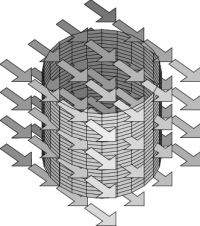Table of Contents
Flux
Prerequisites to Flux
Students need to know how to calculate integrals on surfaces:
- GVC § 1. Surfaces
- GVC § 2. The Cross Product
- GVC § 3. Surface Elements
- Dot Product (for finding the components of vector field perpendicular to surface)
- Cross Product (for finding unit vector normal to surface)
- Electric Field as vector field (for calculating electric flux)
- Surface Element in Rectangular and Curvilinear Coordinates (finding unit vector normal to surface)
- Scalar Surface Integrals (for finding total flux)
- Reading: GVC § Flux–More Flux through a Cube
In-class Content
- Recall Flux (SWBQ - 5 min)
- The Concept of Flux (Kinesthetic Activity - 5 min)
- Calculating Flux (Small Group Activity - 30 min) (Optional)
- Visualizing Electric Flux (Maple - 20 min) - plots electric field vectors from a charge in a box and calculates the flux through the surfaces of the box. Leads to a statement of Gauss' law.
Homework for Static Fields
- (FluxCubeGEM210) This problem is an easy, quick follow-up to test your understanding of fluxem activity, from Griffiths E&M book.
A charge $q$ sits at the corner of a cube. Find the flux of $\EE$ through each side of the cube. Do not do a long calculation (either by hand or by computer)!
- (FluxCylinderMHG19120) This problem is an easy, quick conceptual question about flux, from Hughes Hallett vector calculus book.
- (FluxParaboloid) This problem is a long calculation testing whether you can calculate surface elements and flux in a complicated curvilinear coordinate setting.
Find the upward pointing flux of the electric field $\Vec E =E_0\, z\, \hat z$ through the part of the surface $z=-3 s^2 +12$ (cylindrical coordinates) that sits above the $(x, y)$–plane.

